|
|
|
Sort Order |
|
|
|
Items / Page
|
|
|
|
|
|
|
| Srl | Item |
| 1 |
ID:
090199
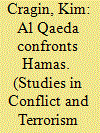

|
|
|
|
|
| Publication |
2009.
|
| Summary/Abstract |
Almost eight years after the September 2001 attacks, U.S. counterterrorism strategy would benefit from a clearer definition of its adversaries. Some have suggested that U.S. counterterrorism policy focus primarily on Sunni jihadists. This term would account for groups such as Al Qaeda and the Abu Sayyaf Group in the Philippines, but not Shi'ite militias in Iraq or Hizbullah. Although any attempt to narrow the scope of U.S. counterterrorism strategy has merit, it is worth noting that important distinctions exist between the various groups. To explore these distinctions, this article examines the different historical trajectories and current arguments between two of the most well-known Sunni jihadists: Al Qaeda and Hamas.
|
|
|
|
|
|
|
|
|
|
|
|
|
|
|
|
| 2 |
ID:
090202
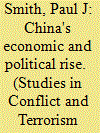

|
|
|
|
|
| Publication |
2009.
|
| Summary/Abstract |
As a rising power in the international system, China is discovering that, like many states before it, the ascendancy to great power status sometimes entails significant terrorism risks. Recent attacks against Chinese nationals (or commercial interests) in Africa, Central Asia, and South Asia appear to reflect this trend. In addition, since the early 1990s, China has endured a series of violent attacks emanating from (or associated with) its restive northwest Xinjiang Uighur Autonomous Region (XUAR). Beijing's search for energy security and its associated commercial activities in the Middle East, Africa, South Asia and Central Asia suggests that terrorism risks for China may increase in the future. In the wake of the 9/11 attacks in the United States and U.S.-Chinese counterterrorism cooperation prior to and during the 2008 Olympic Games, Washington and Beijing have discovered they have many common interests in countering the global threat of terrorism. However, for long-term cooperation to be sustained, the two countries must overcome or manage various disagreements on issues related to terrorism and the larger challenges associated with geopolitical competition. If these differences can be mitigated or resolved, China and the United States may be ideally positioned to establish a powerful and long-term bulwark against international terrorism and the instability that it promotes.
|
|
|
|
|
|
|
|
|
|
|
|
|
|
|
|
| 3 |
ID:
090198
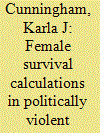

|
|
|
|
|
| Publication |
2009.
|
| Summary/Abstract |
Evolutionary theory's utility for the study of political phenomena, including war and nationalism, has been demonstrated. However, these studies fail to explain substate violence, including terrorism, and rarely evaluate whether cost-benefit analyses differ for males and females. This article seeks to demonstrate that evolutionary theory provides intriguing insights into two phenomena that observers find difficult to understand: political violence, including terrorism and self-sacrifice in the form of suicide attacks, and female political violence.
|
|
|
|
|
|
|
|
|
|
|
|
|
|
|
|
| 4 |
ID:
090201
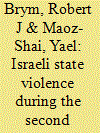

|
|
|
|
|
| Publication |
2009.
|
| Summary/Abstract |
In attempting to explain Israel's retaliatory policies toward Palestinian violence, new institutionalist and rational choice theories vie for dominance. This article argues that both approaches can contribute to understanding the severity of Israel's response if they are viewed as nested explanations appropriate to different threat levels. The article makes its case using data from 74 interviews with senior Israeli counterterrorist experts (2006-07), counts of Israeli and Palestinian fatalities due to state and collective violence (1987-2007), and a database of collective violence events during the Second Intifada (2000-05). Institutional effects are evident at low threat levels, as new institutionalists predict, but these effects are overwhelmed at high threat levels, as rational choice theorists assert.
|
|
|
|
|
|
|
|
|
|
|
|
|
|
|
|
| 5 |
ID:
090203
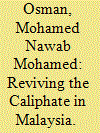

|
|
|
|
|
| Publication |
2009.
|
| Summary/Abstract |
Operating in over 43 countries in the world, Hizbut Tahrir (HT) is presently active in Europe, the Middle East, Africa, and more recently in Asia. Today, HT is becoming increasingly prominent in Southeast Asia, especially in Indonesia and Malaysia. Yet despite its rapid growth in the region, little is known about HT chapters in Southeast Asia, especially in Malaysia. In light of the dearth in scholarship on Hizbut Tahrir Malaysia (HTM), this article aims to shed some light on the HTM and analyze the likelihood of its emergence as a political force in the country.
|
|
|
|
|
|
|
|
|
|
|
|
|
|
|
|
| 6 |
ID:
090200


|
|
|
|
|
| Publication |
2009.
|
| Summary/Abstract |
Terrorist incidents are not random in space or time. Understanding the current spatial and temporal patterns of terrorist incidents, as well as predicting future trends, is vital for effective counterterrorist efforts. This article focuses on terrorist incidents in Iraq, which are defined here as attacks, both successful and unsuccessful, in order to detect patterns in the establishment of terrorist activity spaces. Using Geographic Information Science (GISc), this project carries out a series of spatial and temporal cluster identification analyses on recent terrorist incidents in Iraq.
|
|
|
|
|
|
|
|
|
|
|
|
|
|
|
|
|
|
|
|
|